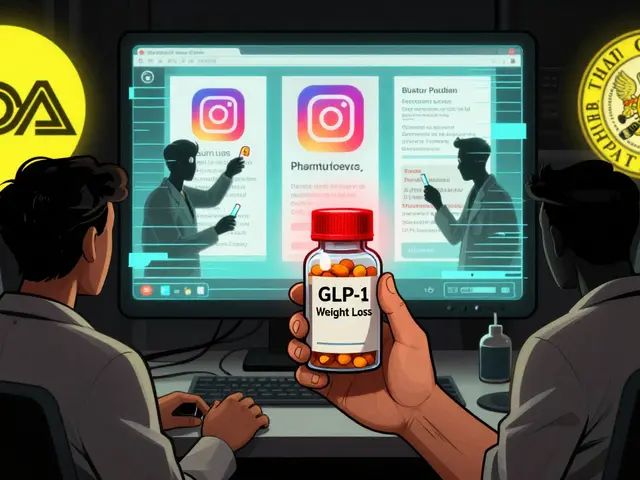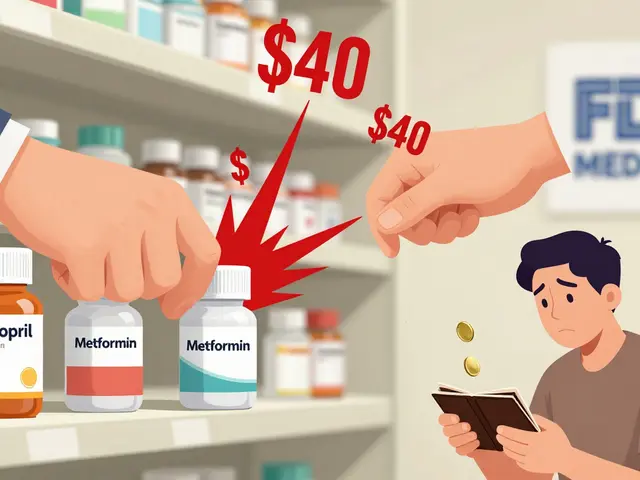
Blood Pressure Medication Selector
Select your health priorities and preferences to find the best blood pressure medication for you.
Your Health Priorities
When your doctor prescribes Procardia (nifedipine), a dihydropyridine calcium‑channel blocker designed to lower blood pressure and relieve angina, you often wonder how it stacks up against other pills you might see on the pharmacy shelf. This guide breaks down the science, the side‑effect profile, dosing quirks, and real‑world cost so you can decide whether Procardia is the right fit or if another option might serve you better.
Quick Takeaways
- Procardia works by relaxing arterial smooth muscle, giving rapid blood‑pressure drops.
- Amlodipine offers once‑daily dosing with fewer flushing episodes.
- Diltiazem and verapamil also block calcium but affect heart rate more strongly.
- ACE inhibitors like lisinopril lower pressure via the renin‑angiotensin system and are kidney‑friendly.
- Beta‑blockers such as metoprolol are best when heart‑rate control is also needed.
How Procardia Works
Nifedipine belongs to the dihydropyridine class of calcium‑channel blockers, targeting L‑type calcium channels in vascular smooth muscle. By preventing calcium influx, the arteries stay relaxed, which drops systemic vascular resistance and, consequently, blood pressure. The drug is absorbed quickly when taken orally, reaching peak plasma concentrations in 30-60 minutes for the immediate‑release form and 4-6 hours for the extended‑release tablets.
Key pharmacokinetic facts:
- Bioavailability: ~70% for immediate‑release, ~80% for extended‑release.
- Half‑life: 2-5 hours (immediate) vs 8-12 hours (extended).
- Metabolism: Primarily hepatic via CYP3A4.
Because it’s metabolized by CYP3A4, drugs that inhibit this enzyme (like erythromycin or grapefruit juice) can spike nifedipine levels, raising the risk of severe hypotension.
Common Alternatives and Their Core Traits
Below is a snapshot of the most frequently prescribed blood‑pressure rivals. Each entry includes the drug class, typical dosing range, and a highlight of what makes it distinct.
- Amlodipine is a long‑acting dihydropyridine calcium‑channel blocker known for once‑daily dosing and minimal facial flushing - 5-10mg daily.
- Diltiazem belongs to the non‑dihydropyridine calcium‑channel blocker group, affecting both vascular tone and heart rate - 120-360mg daily, divided.
- Verapamil is another non‑dihydropyridine calcium‑channel blocker, particularly useful when atrial fibrillation control is needed - 80-240mg daily, divided.
- Lisinopril is an ACE inhibitor that reduces angiotensin‑II formation, lowering both pressure and aldosterone‑driven fluid retention - 5-40mg daily.
- Losartan is an angiotensin‑II receptor blocker (ARB) offering similar blood‑pressure reduction to ACE inhibitors but with a lower cough risk - 25-100mg daily.
- Metoprolol is a beta‑blocker that slows heart rate and reduces cardiac output, useful after myocardial infarction - 25-200mg daily, split.
- Hydrochlorothiazide is a thiazide diuretic that promotes sodium and water excretion, often combined with other agents for synergistic effect - 12.5-50mg daily.
Side‑Effect Landscape
Every medication brings a trade‑off. Understanding the most common adverse events helps you weigh the pros and cons.
| Drug | Flushing / Warm Sensation | Peripheral Edema | Cough / Angioedema | Heart‑Rate Slowdown |
|---|---|---|---|---|
| Procardia (Nifedipine) | 15‑30 | 10‑20 | 0‑2 | 0‑3 |
| Amlodipine | 5‑10 | 12‑18 | 0‑2 | 0‑2 |
| Diltiazem | 2‑5 | 8‑12 | 0‑2 | 5‑12 (bradycardia) |
| Verapamil | 2‑5 | 5‑10 | 0‑2 | 8‑15 (bradycardia) |
| Lisinopril | 0‑2 | 0‑5 | 8‑15 (dry cough) | 0‑2 |
| Losartan | 0‑2 | 0‑5 | 1‑3 (rare cough) | 0‑2 |
| Metoprolol | 0‑2 | 0‑5 | 0‑2 | 15‑25 (bradycardia) |
| Hydrochlorothiazide | 0‑2 | 2‑8 | 0‑2 | 0‑2 |

Choosing the Right Pill - Decision Criteria
Pick a medication based on the following axes. Rank each factor by personal relevance (high, medium, low) and see which drug aligns best.
- Blood‑Pressure Target Speed - If you need a rapid drop (e.g., hypertensive emergency), immediate‑release nifedipine or IV preparations are useful.
- Dosing Convenience - Once‑daily agents like amlodipine or lisinopril improve adherence.
- Co‑existing Heart Conditions - Beta‑blockers and non‑dihydropyridine CCBs help with arrhythmias or post‑MI care.
- Kidney Health - ACE inhibitors and ARBs protect renal function, especially in diabetic patients.
- Side‑Effect Tolerance - If flushing bothers you, avoid nifedipine; if cough is a problem, skip ACE inhibitors.
- Drug Interactions - CYP3A4 inhibitors raise nifedipine levels, while grapefruit juice can do the same.
Cost and Accessibility in Australia (2025)
Price matters, especially when you’re on a long‑term script. Approximate PBS (Pharmaceutical Benefits Scheme) subsidized costs:
- Procardia 30mg extended‑release - AU$5 per month.
- Amlodipine 5mg - AU$4 per month.
- Diltiazem 120mg - AU$6 per month.
- Lisinopril 10mg - AU$3 per month.
- Losartan 50mg - AU$4 per month.
- Metoprolol 50mg - AU$4 per month.
- Hydrochlorothiazide 25mg - AU$2 per month.
Generic nifedipine tablets often cost less than the branded Procardia, but the extended‑release formulation may only be available under the brand name, affecting out‑of‑pocket spend.
Practical Tips for Switching or Adding a New Agent
- Never stop Procardia abruptly; taper over 2-3 days to avoid rebound hypertension.
- When introducing an ACE inhibitor, monitor potassium and creatinine levels after 2 weeks.
- If you combine a CCB with a diuretic, watch for excessive drops in blood pressure during the first week.
- Keep a log of any new symptoms-headaches, dizziness, swelling-and share it with your GP.
Bottom Line
Procardia shines when you need quick, potent vasodilation, but its flushing and interaction profile can be a turn‑off. Amlodipine offers a smoother daily rhythm, while non‑dihydropyridine CCBs bring heart‑rate control into the mix. ACE inhibitors and ARBs protect kidneys and avoid the flushing issue, and beta‑blockers tackle both pressure and rhythm problems. Your personal health picture-heart disease, kidney function, lifestyle, and cost-will dictate the best match.
Frequently Asked Questions
Can I take Procardia with a diuretic?
Yes, many doctors combine nifedipine with a thiazide diuretic like hydrochlorothiazide to boost blood‑pressure control. Start with a low diuretic dose and watch for an abrupt drop in pressure.
Why does Procardia cause flushing?
Nifedipine dilates blood vessels in the skin as well as the arteries supplying the heart. The sudden widening releases heat, which you feel as a warm, red flush.
Is the extended‑release form more expensive than generic nifedipine?
Typically, yes. The extended‑release tablets are often only sold under the Procardia brand in Australia, while immediate‑release nifedipine is widely available as a generic at a lower cost.
What should I do if I develop a dry cough on an ACE inhibitor?
Talk to your GP; they may swap lisinopril for an ARB like losartan, which has a much lower cough risk while providing similar blood‑pressure benefits.
Can grapefruit juice affect my Procardia dose?
Yes. Grapefruit blocks the CYP3A4 enzyme that breaks down nifedipine, potentially raising drug levels and causing unwanted low blood pressure. It’s safest to avoid large amounts.
14 Comments
Marlene Schanz
September 29, 2025 at 03:29 AM
I think the biggest takeaway is that you don’t have to lock yourself into one pill forever.
If you’re chill about side‑effects, Amlodipine’s once‑daily vibe is a solid win.
For folks worrying about kidney health, an ARB like Losartan often feels safer.
The cost differences in Australia are pretty tight, so you can trial a couple without breaking the bank.
Just keep a symptom journal and share it with your GP – that’s the easiest way to find your sweet spot.
Matthew Ulvik
September 29, 2025 at 03:30 AM
Yo, if you’re mixing nifedipine with a thiazide, start low and watch that BP dip.
Don’t forget to log any weird headaches or swelling – those are red flags.
Oh, and a quick smiley :) just to keep the vibes friendly.
Dharmendra Singh
September 29, 2025 at 03:30 AM
Look, i thnik the main point is to avoid grapefruit juice because it messes up the cyp3a4 pathyway.
Also, if you have any kidney issues, consider a low dose ace inhibitor instead of nifedipine.
the extended release is more convenient but cost may be higher.
pay attention to any swelling or flushing, they can be a sign to adjust dosage.
Rocco Abel
September 29, 2025 at 03:31 AM
Pharma push this calcium‑channel blocker like it’s the only answer, but the hidden agenda is in the profit margins.
The extended‑release formula keeps you dependent on the brand, ensuring steady sales.
If you’re not buying into the corporate hype, look at generic alternatives that work just as well.
Don’t let big‑drug marketing dictate your health choices.
Dawn Mich
September 29, 2025 at 03:32 AM
Enough with the conspiracy spiel – the data is clear, Procardia does its job if you tolerate the side‑effects.
If you can’t handle flushing, just pick a different class.
Eric Sevigny
September 29, 2025 at 03:33 AM
Just a heads‑up: when you start a new antihypertensive, give it a couple of weeks before adding another – you’ll avoid over‑lowering your pressure.
Also, keep an eye on potassium if you pair with an ACE inhibitor.
Small typo in the table – “Side‑Effect” column for Metoprolol should read “15‑25” for bradycardia, not “15‑25 (bradycardia)”.
Overall, the guide is solid, just double‑check numbers.
Glenda Rosa
September 29, 2025 at 03:34 AM
Alright, let’s cut through the fluff – Procardine’s flush is basically a neon sign that says “I’m over‑stimulating your skin”.
Meanwhile, Amlodipine whispers “I’m here, but I won’t betray you with a rosy glow”.
The cost battle is a joke; you’re paying more for a brand label than the actual drug.
If you love drama, stick with the rapid‑release nifedipine and enjoy the roller‑coaster; if you prefer stability, grab a generic ARB.
Bottom line: don’t let the pharma hype dictate your wallet and skin tone.
charlise webster
September 29, 2025 at 03:34 AM
I see your point about the branding costs, but it’s also true that some patients find the extended‑release formulation easier to stick with.
lata Kide
September 29, 2025 at 03:35 AM
OMG, the flushing is like a fireworks show on your face! 🎆🔥💥
Mark Eddinger
September 29, 2025 at 03:35 AM
Regarding the article, the phrase “The drug is metabolized primarily hepatic via CYP3A4.” would be more precise as “The drug is primarily metabolized hepatically via CYP3A4.” Additionally, the term “renal‑compromised” should be hyphenated as “renal‑compromised.” These minor edits improve clarity and adherence to standard medical style.
Francisco Garcia
September 29, 2025 at 03:37 AM
I appreciate the thorough comparison; it really helps to see side‑effect percentages side by side.
From a practical standpoint, the once‑daily dosing of Amlodipine fits my routine better than splitting doses.
Also, the kidney‑protective effect of ACE inhibitors is a decisive factor for diabetic patients.
One thing to note is that while Procardia offers rapid pressure drops, it may not be ideal for chronic management due to its flushing.
Overall, matching the medication to personal health priorities, as the guide suggests, is the best approach.
Keep tracking how you feel and adjust with your doctor’s guidance.
Patrick Renneker
September 29, 2025 at 03:39 AM
In light of the extensive pharmacodynamic and pharmacokinetic data presented herein, it becomes evident that the selection of a antihypertensive agent must be predicated upon a multifactorial assessment encompassing not only the hemodynamic objectives but also the individual’s comorbid profile, tolerability spectrum, and socioeconomic considerations; consequently, while Procardia (nifedipine) demonstrates commendable efficacy in inducing swift vasodilation, its propensity for inducing peripheral flushing, edema, and potential drug‑drug interactions, particularly via CYP3A4 inhibition, renders it suboptimal for patients with heightened sensitivity to such adverse manifestations, thereby necessitating the contemplation of alternative classes such as long‑acting dihydropyridine agents like amlodipine, non‑dihydropyridine calcium‑channel blockers for rhythm control, or renin‑angiotensin system modulators for renal preservation; furthermore, the economic implications delineated within the Australian PBS framework underscore the importance of scrutinizing brand‑specific pricing structures, especially concerning extended‑release formulations, which may impose a disproportionate financial burden relative to generic counterparts, thus advocating for a judicious, patient‑centered therapeutic strategy that harmonizes clinical efficacy with tolerability and affordability.
KAYLEE MCDONALD
September 29, 2025 at 03:40 AM
Stay safe and keep your doctor in the loop.






Brenda Martinez
September 29, 2025 at 03:29 AM
Let me break down why Procardia feels like a roller‑coaster ride for anyone with a delicate side‑effect tolerance.
First, the flushing it causes is not just a harmless pink hue; it signals massive peripheral vasodilation that can leave you looking like a lobster on a summer beach.
Second, the rapid onset of the immediate‑release form can drop your pressure so fast that you might feel light‑headed within minutes, which is terrifying for anyone prone to dizziness.
Third, because it’s metabolized by CYP3A4, the slightest thing – a spoonful of grapefruit juice or a course of erythromycin – can catapult the drug level into dangerous territory, increasing the risk of severe hypotension.
Fourth, the extended‑release version, while more convenient, locks you into a brand name that often costs more than generic equivalents, putting a strain on tight budgets.
Fifth, compared to Amlodipine, Procardia’s edema rate is on par, but its flushing frequency is three times higher, making it a less attractive option for those who hate a swollen appearance.
Sixth, the drug’s half‑life variability (2‑5 hours for IR, 8‑12 hours for XR) means you have to be mindful of dosing intervals to avoid peaks and troughs that can destabilize blood pressure control.
Seventh, if you’re also on a thiazide diuretic, the combined effect can be a double‑edged sword, delivering powerful pressure drops but also amplifying the chance of electrolyte imbalances.
Eighth, for patients with heart rhythm issues, Procardia offers no benefit; non‑dihydropyridine CCBs like Diltiazem or Verapamil would be far more appropriate.
Ninth, in renal‑compromised individuals, the drug’s hepatic clearance doesn’t provide the kidney‑protective edge that ACE inhibitors or ARBs deliver.
Tenth, the price point, while modest on the PBS, masks the hidden cost of monitoring – you’ll need frequent appointments to check for side‑effects and interactions.
Eleventh, the drug’s “quick‑drop” reputation makes it unsuitable for chronic, stable hypertension where a smoother, once‑daily agent like Lisinopril or Losartan is preferable.
Twelfth, patient education is crucial; many people don’t realize they must avoid abrupt discontinuation to prevent rebound hypertension, a fact often omitted in hurried prescriptions.
Thirteenth, the extended‑release tablet’s lack of generic options forces patients into a brand‑locked market, reducing accessibility for low‑income groups.
Fourteenth, the overall risk‑benefit ratio tilts toward alternatives unless you specifically need rapid vasodilation in an acute setting.
Fifteenth, the clinical guidelines increasingly favor agents that offer both blood‑pressure control and organ protection, which Procardia sadly lacks.
Finally, if you’re weighing options, consider your personal side‑effect tolerance, kidney function, and whether you can afford the ancillary monitoring – most folks will find a smoother, cheaper, and safer pill elsewhere.